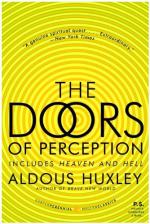|
This section contains 503 words (approx. 2 pages at 400 words per page) |

|
The Doors of Perception, and Heaven and Hell Summary & Study Guide Description
The Doors of Perception, and Heaven and Hell Summary & Study Guide includes comprehensive information and analysis to help you understand the book. This study guide contains the following sections:
This detailed literature summary also contains Topics for Discussion and a Free Quiz on The Doors of Perception, and Heaven and Hell by Aldous Huxley.
The Doors of Perception & Heaven and Hell by Aldous Huxley is a volume containing two essays on the subject of visionary experiences, transcendence, and truth. The work is philosophical in nature and presents many ideas that may seem controversial or difficult to understand. Huxley's experiences and opinions with the subject matter make him an informative author. The main themes of the book are transcendence, utility, thought, and self-awareness.
The first essay in this book, "The Doors of Perception," describes an experiment that the author enters into in 1953 to test the effects of mescalin (more commonly spelled mescaline, but mescalin is what Huxley uses throughout), the psychedelic ingredient in peyote. The essay explains how the author comes to be involved in the experiment and what happens while he is under the influence of the drug. Huxley also broadly explores why people take drugs, some of what they experience when they are under the influence of drugs, and the need for all people to have visionary experiences. Huxley describes the visions he has while under mescalin in very vivid terms. He relates many of them to the works of famous artists or authors both to better explain his visions to the reader and to prove the powerful visionary effects that art can produce. Huxley also makes reference to a variety of religious beliefs throughout this essay. Religion becomes especially important when he discusses his views on why people take drugs and how people try to achieve visionary experiences.
The second essay, "Heaven and Hell," provides a more general analysis of the ability of human beings to achieve transcendence and knowledge. Unlike "The Doors of Perception," "Heaven and Hell" does not recount any specific experience that the author had with mescalin. Instead, Huxley examines the reasons human beings explore their minds, the things that occur when someone is having a visionary experience, some of the techniques people have used throughout history to achieve a state of knowledge, and some of the pros and cons of different approaches. Again, Huxley relies on the work of artists, authors, and philosophers throughout history to demonstrate the power of these mediums to achieve visionary experiences. Also, these mediums are discussed in relation to religion and religious practices as well. Ultimately, Huxley discusses heaven and hell and a middle ground that he feels can be reached through the use of mescalin. In this discussion, Huxley also focuses on the importance of the state of mind of the person who is attempting to have a visionary experience. This includes individuals who have illnesses such as schizophrenia or people who are sinful. When these individuals attempt to reach heaven or hell, they will find themselves stuck in a dark middle ground from which they cannot escape.
Huxley's book concludes with eight appendices that attempt to clarify and expand on some of the points made in "Heaven and Hell." Each of these has a different topic, but all of them support Huxley's message about visionary experiences and heaven and hell.
Read more from the Study Guide
|
This section contains 503 words (approx. 2 pages at 400 words per page) |

|



